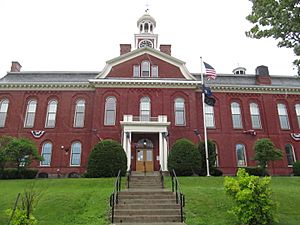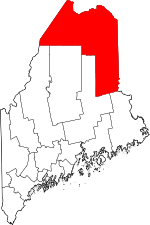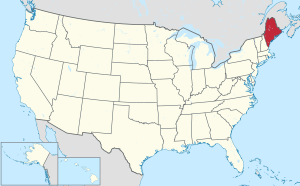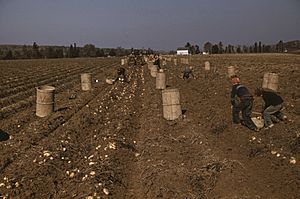Aroostook County, Maine facts for kids
Quick facts for kids
Aroostook County
|
|||
|---|---|---|---|

Aroostook County Courthouse
|
|||
|
|||

Location within the U.S. state of Maine
|
|||
 Maine's location within the U.S. |
|||
| Country | |||
| State | |||
| Founded | May 1, 1839 | ||
| Named for | Miꞌkmaq word meaning "beautiful water" | ||
| Seat | Houlton | ||
| Largest city | Presque Isle | ||
| Area | |||
| • Total | 6,828 sq mi (17,680 km2) | ||
| • Land | 6,671 sq mi (17,280 km2) | ||
| • Water | 156 sq mi (400 km2) 2.3% | ||
| Population
(2020)
|
|||
| • Total | 67,105 | ||
| • Density | 9.8279/sq mi (3.79458/km2) | ||
| Time zone | UTC−5 (Eastern) | ||
| • Summer (DST) | UTC−4 (EDT) | ||
| Congressional district | 2nd | ||
Aroostook County ( ə-ROOS-tək; French: Comté d'Aroostook) is a county in the U.S. state of Maine along the Canada–U.S. border. As of the 2020 census, the population was 67,105. Its seat is Houlton with offices in Caribou and Fort Kent.
Known locally in Maine as "The County", it is the largest county in Maine by total area, and the second largest in the United States by land area east of the Mississippi River, behind St. Louis County, Minnesota. With over 6,800 square miles of land it is larger than three U.S. states. It is Maine's northernmost county. Its northernmost village, Estcourt Station, is also the northernmost community in New England and in the contiguous United States east of the Great Lakes.
Aroostook County is known for its potato crops. The county is also an emerging hub for wind power. Its Acadian culture is also well-known. In the Saint John Valley in the northern part of the county, which borders Madawaska County, New Brunswick, many of the residents are bilingual in English and Acadian French, whereas elsewhere in Maine, New England French is the predominant form of French spoken.
Contents
History
Aroostook County was formed in 1839 from parts of Penobscot and Washington counties. In 1843, Aroostook gained land from Penobscot County; in 1844, Aroostook again gained land from Penobscot, plus it exchanged land with Piscataquis County. In 1889, Aroostook gained slightly from Penobscot, but gave back the land in 1903 when Aroostook County gained its final form. Some of the territory in this county was part of the land dispute that led to the "Aroostook War" that would eventually be settled by the Webster–Ashburton Treaty.
The county was also part of a route on the Underground Railroad, and was one of the last stops before entering Canada. Slaves would meet and hide just outside Aroostook or in deserted areas. Friends Quaker Church near Fort Fairfield was often a final stop.
During the post World War II era, much of Aroostook County's economy was dominated by military spending. In 1947, the Limestone Army Air Field was built in Limestone, Maine. It began use in 1953 and was renamed the Loring Air Force Base. Aroostook County was chosen due to its strategic location as the closest point in the Continental United States to Europe. The 1991 Base Realignment and Closure Commission recommended closure of Loring and the Base closed in 1994.
The 2014 Acadian World Congress was held along the Canada–United States border, co-hosted by Aroostook County and a number of neighboring counties in Canada (Témiscouata in Quebec, and Victoria, Madawaska and Restigouche in New Brunswick). Organizers planned a Tintamarre that was held in the town of Madawaska, Maine, as well as a giant tug of war across the Saint John River.
Geography
According to the U.S. Census Bureau, the county has a total area of 6,828 square miles (17,680 km2), of which 6,671 square miles (17,280 km2) is land and 156 square miles (400 km2) (2.3%) is water. Aroostook County is the largest county in Maine by area, about the size of Connecticut and Rhode Island combined.
Adjacent counties and municipalities
- Washington County, Maine – southeast
- Penobscot County, Maine – south
- Piscataquis County, Maine – south
- Somerset County, Maine – southwest
- Montmagny Regional County Municipality, Quebec – west
- L'Islet Regional County Municipality, Quebec – west
- Kamouraska Regional County Municipality, Quebec – northwest
- Témiscouata Regional County Municipality, Quebec – north
- Madawaska County, New Brunswick – northeast
- Victoria County, New Brunswick – east
- Carleton County, New Brunswick – east
- York County, New Brunswick – southeast
National protected area
Major highways
 I-95
I-95 US 1
US 1 US 1A
US 1A US 2
US 2 US 2A
US 2A SR 10
SR 10 SR 11
SR 11 SR 89
SR 89 SR 161
SR 161 SR 164
SR 164 SR 171
SR 171
Demographics
| Historical population | |||
|---|---|---|---|
| Census | Pop. | %± | |
| 1840 | 9,413 | — | |
| 1850 | 12,529 | 33.1% | |
| 1860 | 22,479 | 79.4% | |
| 1870 | 29,609 | 31.7% | |
| 1880 | 41,700 | 40.8% | |
| 1890 | 49,589 | 18.9% | |
| 1900 | 60,744 | 22.5% | |
| 1910 | 74,664 | 22.9% | |
| 1920 | 81,728 | 9.5% | |
| 1930 | 87,843 | 7.5% | |
| 1940 | 94,436 | 7.5% | |
| 1950 | 96,039 | 1.7% | |
| 1960 | 106,064 | 10.4% | |
| 1970 | 92,463 | −12.8% | |
| 1980 | 91,331 | −1.2% | |
| 1990 | 86,936 | −4.8% | |
| 2000 | 73,938 | −15.0% | |
| 2010 | 71,870 | −2.8% | |
| 2020 | 67,105 | −6.6% | |
| U.S. Decennial Census 1790–1960 1900–1990 1990–2000 2010–2016 |
|||
2010 census
As of the 2010 United States Census, there were 71,870 people, 30,961 households, and 19,578 families residing in the county. The population density was 10.8 inhabitants per square mile (4.2/km2). There were 39,529 housing units at an average density of 5.9 per square mile (2.3/km2). The racial makeup of the county was 95.7% white, 1.7% Native American, 0.6% black or African American, 0.4% Asian, 0.2% from other races, and 1.4% from two or more races. Those of Hispanic or Latino origin made up 0.9% of the population. In terms of ancestry, 27.2% were French, 18.1% were English, 17.4% were Irish, 8.2% were French Canadian, 8.1% were American, and 5.2% were German.
Of the 30,961 households, 25.5% had children under the age of 18 living with them, 49.6% were married couples living together, 9.4% had a female householder with no husband present, 36.8% were non-families, and 30.8% of all households were made up of individuals. The average household size was 2.26 and the average family size was 2.79. The median age was 45.3 years.
The median income for a household in the county was $36,574 and the median income for a family was $47,114. Males had a median income of $37,222 versus $28,244 for females. The per capita income for the county was $20,251. About 10.6% of families and 15.4% of the population were below the poverty line, including 20.4% of those under age 18 and 11.7% of those age 65 or over.
Communities
Cities
Incorporated towns
- Allagash
- Amity
- Ashland
- Bancroft
- Blaine
- Bridgewater
- Castle Hill
- Caswell
- Chapman
- Crystal
- Dyer Brook
- Eagle Lake
- Easton
- Fort Fairfield
- Fort Kent
- Frenchville
- Grand Isle
- Hamlin
- Hammond
- Haynesville
- Hersey
- Hodgdon
- Houlton (county seat)
- Island Falls
- Limestone
- Linneus
- Littleton
- Ludlow
- Madawaska
- Mapleton
- Mars Hill
- Masardis
- Merrill
- Monticello
- New Canada
- New Limerick
- New Sweden
- Oakfield
- Orient
- Perham
- Portage Lake
- Saint Agatha
- Saint Francis
- Sherman
- Smyrna
- Stockholm
- Van Buren
- Wade
- Wallagrass
- Washburn
- Westfield
- Westmanland
- Weston
- Woodland
Plantations
Census-designated places
Unincorporated communities within towns
- Clayton Lake
- Crouseville
- Estcourt Station
- Fort Kent Mills
- Maine
- Portage
- Saint David
- Sinclair
- Smyrna Mills
- Wytopitlock
Unorganized territories
Indian reservations
- Aroostook Band of Mi'kmaq Indians Reservation, located in Presque Isle
- Houlton Band of Maliseet Indians Reservation, located in Houlton
See also
 In Spanish: Condado de Aroostook para niños
In Spanish: Condado de Aroostook para niños




